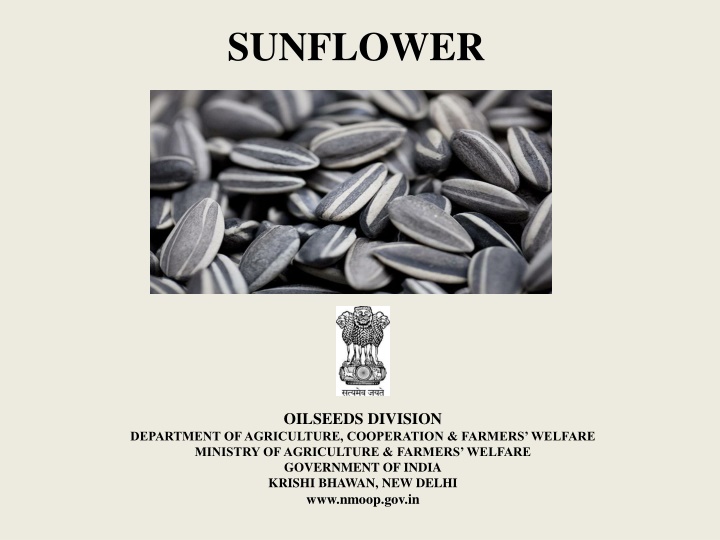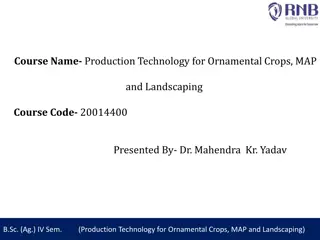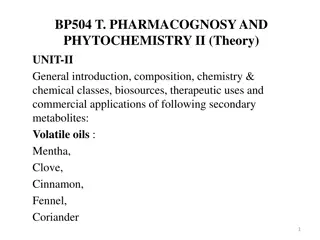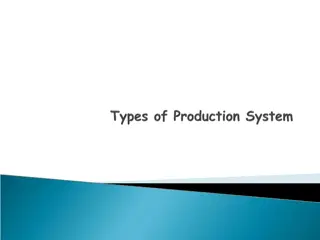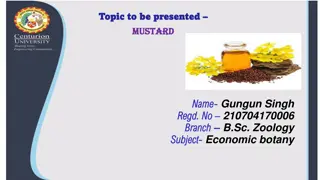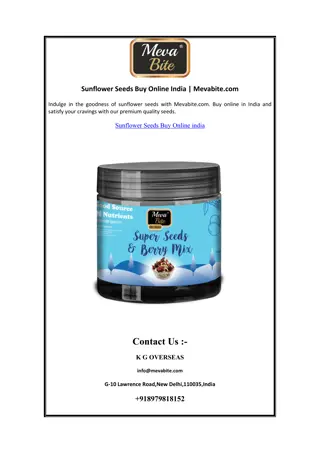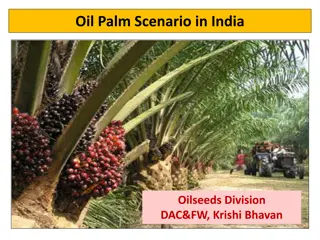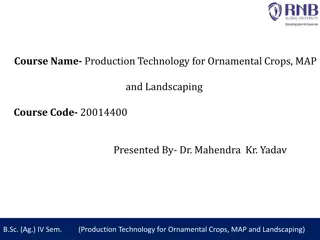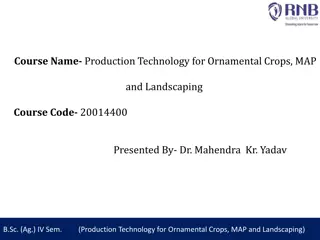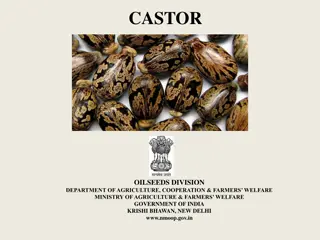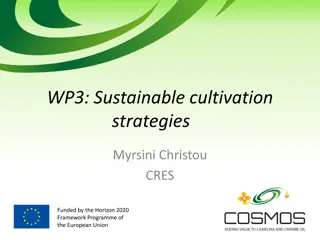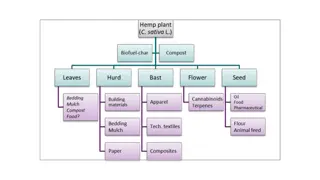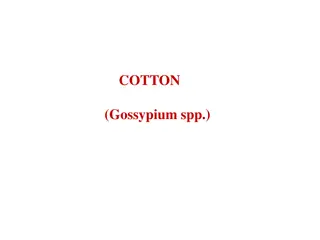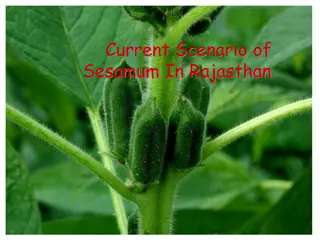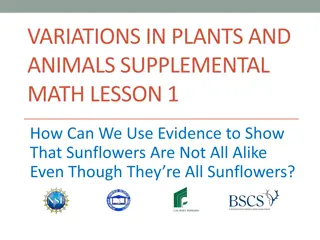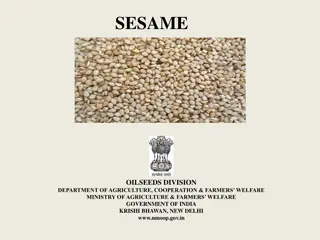Sunflower Cultivation: Global Scenario and Production Data
Sunflower cultivation is a significant agricultural activity worldwide, with major producing countries like Russia, Ukraine, China, and India. The plant, scientifically known as Helianthus annuus, thrives in diverse climates and contributes to oilseed production. This summary explores sunflower cultivation areas, production, and yields across key countries, highlighting the crop's economic importance and global reach.
Download Presentation

Please find below an Image/Link to download the presentation.
The content on the website is provided AS IS for your information and personal use only. It may not be sold, licensed, or shared on other websites without obtaining consent from the author.If you encounter any issues during the download, it is possible that the publisher has removed the file from their server.
You are allowed to download the files provided on this website for personal or commercial use, subject to the condition that they are used lawfully. All files are the property of their respective owners.
The content on the website is provided AS IS for your information and personal use only. It may not be sold, licensed, or shared on other websites without obtaining consent from the author.
E N D
Presentation Transcript
SUNFLOWER OILSEEDS DIVISION DEPARTMENT OF AGRICULTURE, COOPERATION & FARMERS WELFARE MINISTRY OF AGRICULTURE & FARMERS WELFARE GOVERNMENT OF INDIA KRISHI BHAWAN, NEW DELHI www.nmoop.gov.in
BOTANICAL DESCRIPTION Family: Asteraceae Common name : Surajmukhi Scientific name : Helianthus annus L. Origin : Southern United States and Mexico
SEASON AND CLIMATE Season : All the seasons and across the country Climate : Semi-arid region of Deccan Plateau and Northern Plains Temperature : Low temperature (3-60C) for germination, optimum temperature for growth 20-260C
GLOBAL SCENARIO Sunflower is grown over an area of more than 25 million ha in about 70 countries with a world average yield of 1637 kg/ha Russia, Ukraine, Romania, China, Kazakhstan, Spain, Bulgaria, France, India, Turkey, South Africa, USA and Myanmar are the major sunflower growing countries Russia and Ukraine have the largest share of about 50% in total sunflower production in the world China, Turkey, Bulgaria and France are the highest yielding countries with an average yield of more than 2.0 tonnes/ha as against less than 1.0 tonne per ha by India
AREA, PRODUCTION AND YIELD OF MAJOR SUNFLOWER GROWING COUNTRIES Country Area (lakh ha) S. No Production (lakh tonnes) Yield (kg/ha) 2012-13 2013-14 2014-15 2012-13 2013-14 2014-15 2012-13 2013-14 2014-15 61.59 67.96 64.43 79.93 105.54 50.82 50.90 52.12 83.87 110.51 10.65 10.72 9.98 13.98 21.42 1 2 3 Russian Fed Ukraine Romania 90.34 101.34 21.89 1298 1651 1313 1553 2171 1998 1402 1944 2194 4 5 6 7 9 10 11 China Bulgaria Spain Kazakhstan India Turkey France 8.88 7.81 7.61 6.82 8.20 6.05 6.80 9.23 8.79 8.49 8.18 6.80 6.10 7.71 9.30 8.44 7.83 7.65 7.30 6.58 6.57 23.23 13.88 6.19 4.00 5.44 13.70 15.73 24.23 19.74 10.29 5.73 5.04 15.23 15.82 23.80 20.11 9.81 5.13 4.15 16.38 15.59 2614 1777 813 587 663 2265 2313 2624 2247 1212 700 741 2498 2053 2559 2384 1253 670 569 2491 2372 12 13 USA South Africa Myanmar World 7.45 5.00 5.93 5.05 6.10 5.99 12.41 6.30 9.17 5.57 10.05 8.32 1667 1260 1547 1103 1647 1189 14 5.40 5.70 5.90 3.50 3.60 3.80 648 1495 632 1746 644 1669 248.06 254.74 247.62 370.87 444.66 413.35 Source: Oilseeds Statistics: A Compendium-2015, ICAR-IIOR, Hyderabad
AVERAGE AREA (LAKH HA) OF MAJOR SUNFLOWER GROWING COUNTRIES (2012-13 TO 2014-15) 1 Russian Fed. 2 Ukraine 3 Romania 52.52 64.66 4 China 5 Bulgaria 5.35 5.67 6 Spain 6.24 6.49 7 Kazakhstan 7.03 51.28 8 India 7.43 7.55 9 France 7.98 8.35 9.14 10.45 10 USA 11 Turkey 12 Myanmar 13 South Africa 14 Others
AVERAGE PRODUCTION (LAKH TONNES) OF MAJOR SUNFLOWER GROWING COUNTRIES (2012-13 TO 2014-15) 1 Ukraine 2 Russian Fed. 3 China 88.06 98.57 4 Romania 5 Bulgaria 3.63 4.88 4.95 6.73 6 France 8.76 10.54 7 Turkey 15.1 8 USA 91.94 15.71 17.91 9 Spain 19.1 23.75 10 South Africa 11 Kazakhstan 12 India 13 Myanmar 14 Others
NATIONAL SCENARIO Area, production and yield of sunflower in India during last 3 years 800.00 700.00 600.00 2013-14 500.00 2014-15 400.00 300.00 2015-16 200.00 100.00 0.00 Area (`000 ha) Production (`000 tonne) Yield (q/ha)
AVERAGE AREA, PRODUCTION AND YIELD IN INDIA (2013-14 TO 2015-16) State Area (`000 ha) Karnataka 367.00 Production (`000 tonnes) 208.00 Yield (kg/ha) 563 Andhra Pradesh 58.67 43.67 845 Maharashtra 61.00 27.67 407 Odisha 20.86 24.97 1196 Telangana 16.67 19.67 1197 Bihar 12.63 17.88 1418 West Bengal 13.67 19.67 1438 Punjab 8.77 15.53 1778 Tamil Nadu 8.30 11.25 1354 Haryana 10.53 27.37 2567 All India 578.53 422.95 728
POTENTIAL STATES AND DISTRICTS OF SUNFLOWER Sr. No. State Districts Avg. area 2011-12 to 2013-14 (`000 ha) 61.1 Raichur 1 Karnataka Gadag 49.9 Koppal 49.6 Bagalkot 46.7 Gulbarga 41.3 Bellary 27.3 Chitradurga 27.1 Belgaum 13.5 YRS Kadapa 46.4 2 Andhra Pradesh Kurnool Prakasam Ananthapuram 28.3 14.1 12.6
POTENTIAL STATES AND DISTRICTS OF SUNFLOWER (contd) Sr. No. State Districts Avg. area 2011-12 to 2013-14 (`000 ha) 40.6 Osmanabad 3 Maharashtra 19.9 Latur 19.6 Solapur Madhepura 5.6 4 Bihar Supaul 5.3 4.7 Paschim Medinipur 5. West Bengal 4.7 South 24 Parganas
NEW/NON-TRADITIONAL AREAS As sunflower is largely photo and thermo-insensitive, there is scope to grow the crop in all the seasons of the year. It can be introduced as a contingent crop when the season for planting regular crop is delayed or the regular crop has failed. Some potential areas for introducing sunflower are : In kharif fallows, as mid-season contingency crop in central and peninsular India. As a summer crop after potato, mustard, sugarcane, pea, cotton, vegetables and late rice in Punjab, Haryana, Uttar Pradesh, Bihar and West Bengal. As an alternative crop for sorghum under delayed onset of monsoon in peninsular India. In rice-fallow areas with supplemental irrigation in Odisha, Chhattisgarh, Andhra Pradesh, Maharashtra and Karnataka. As an intercrop with finger millet, pigeon pea, groundnut, soybean, castor, sesame, black gram and green gram in different regions.
CROPPING SYSTEMS Due to its wider adaptability, the crop is ideally suited for intercropping system About 10% area of sunflower is under intercropping Sunflower + pigeon pea and sunflower + groundnut are popular in southern states Sunflower + castor in Andhra Pradesh and Gujarat is prevalent Sunflower + soybean in Marathwada and Vidarbha region of Maharashtra is popular Sunflower + black gram in Uttar Pradesh is found to be efficient On an average, groundnut + sunflower registered 36% yield advantage, while pigeon pea + sunflower gave 23% additional yield advantage over sole crop of sunflower
INTERCROPPING SYSTEMS State Soil Type Efficient Intercropping Row Ratio Karnataka Alfisol Alfisol Vertisol Alfisol Vertisol Vertisol Vertisol Alfisol Alfisol Alfisol Alfisol Alfisol Alfisol Vertisol Inceptisol Groundnut+Sunflower Pigeonpea+Sunflower Pigeonpea+Sunflower Fingermillet+Sunflower Pigeonpea+Sunflower Soybean+Sunflower Groundnut+Sunflower Groundnut+Sunflower Pigeonpea+Sunflower Castor+Sunflower Groundnut+Sunflower Castor+Sunflower Groundnut+Sunflower Castor+Sunflower Black gram/Green gram + Sunflower 4:2, 3:1 1:2 / 1:1 3:1 4:2 3:3 2:1 6:2 4:2 1 :2 1: 1 3:1 1:1 1:1 1:1 4:2 / 3:1 Maharashtra Andhra Pradesh Tamil Nadu Gujarat Non-traditional Areas
YIELD GAPS IN SUNFLOWER State Yield (kg/ha) Yield Gap (%) SAY FLD Kharif-2013 607 Karnataka 1953 221.75 Maharashtra 620 1604 158.71 Tamil Nadu 1564 2166 38.49 Average 750 1814 141.87 Source: NMOOP Frontline Demonstrations on Oilseeds 2013-14, ICAR-IIOR, Hyderabad
VARIETY AND SEED SCENARIO Indian Institute of Oilseeds Research (IIOR), an Institution of ICAR is entrusted with crop improvement of sunflower A large number of hybrids and composite varieties of sunflower have been developed by both public and private sectors
PREFERRED HYBRIDS VARIETIES State Hyb/Vars Name of varieties / hybrids Andhra Pradesh Hybrids BSH-1, APSH-11, MSFH-8, KBSH-1, MSFH-17, Jwalamukhi, Sungene-85, MLSFH-47, KBSH-44, Pro.Sun.09, NDSH-1, SH-416, DRSH-1 PAC-36, PAC-1091, Varieties Morden, TNAUSUF-7, DRSF-108, DRSF-113 Haryana Hybrids BSH-1, KBSH-1, Jwalamukhi, Sungene-85, PAC-36, KBSH-44, Pro. Sun. 09, HSFH-848, DRSH-1 Karnataka Hybrids BSH-1, MSFH-8, KBSH-1, MSFH-17, Jwalamukhi, Sungene-85, PAC-36, PAC-1091, DSH-1, MLSFH-47, KBSH-41, KBSH-42, KBSH 44, Pro.Sun 09, RSFH-1, SH-416, KBSH-53, DRSH-1 Varieties Morden, TNAUSUF-7, DRSF-108, DRSF-113
PREFERRED HYBRIDS VARIETIES (contd) State Hyb/Vars Name of varieties / hybrids Maharashtra Hybrids BSH-1, MSFH-8, KBSH-1, MSFH-17, LSH-1, LSH- 3, PKVSH-27, Sungene-85, PAC-36, PAC-1091, MLSFH-47, KBSH-44, Pro Sun 09, SH-416, DRSH- 1, LSFH-35 Varieties Morden, (Sidhweswar), DRSF-108, DRSF-113, TAS-82, LSF- 8, PKVSF-9, Phule Raviraj TNAUSUF-7, Surya, SS-56, LS-11 Punjab Hybrids BSH-1, KBSH-1, PSFH-67, Jwalamukhi, Sungene- 85, PAC-36, PSFH-118, KBSH-44, DRSH-1, PSFH- 118, PSFH 569 Tamil Nadu Hybrids BSH-1, MSFH-8, KBSH-1, MSFH-17, Jwalamukhi, Sungene-85, PAC-36, PAC-1091, TCSH-1, MLSFH- 47, KBSH-44, Pro. Sun. 09, SH. 416, DRSH-1 Morden, TNAUSUF-7, CO-1, CO-2, DRSF-108, DRSF-113, COSFV-5 Varieties
PACKAGE AND PRACTICES Soil: Sunflower performs well on a wide range of soils such as sandy loams, black soils and alluviums. It does best on fertile, well- drained neutral soils As a rainfed crop during rabi season, sunflower can profitably be cultivated in moisture retentive soils like Vertisoils The ideal pH is around 6.5-8.0 Though can tolerate slight alkaline conditions but not acidity Sowing Time: Although sunflower is recommended for cultivation in all the seasons, its performance is superior in rabi or spring/early summer Sowing time should be decided in such a way that the flowering and seed filling stages of the crop do not coincide with continuous rainy period or high temperatures above 38 C
PACKAGE AND PRACTICES (contd) State Kharif Maharashtra July 1st week October Rabi Summer 1st fortnight of Last week of January to First week of February. January to 1st fortnight of February. Karnataka July 2nd fortnight of September to 1st fortnight of October Tamil Nadu Mid July 1st week of November Mid February Andhra Pradesh July 10 to August 20 - 2nd fortnight of November - - Punjab, Haryana, Uttar Pradesh, Bihar, West Bengal, Odisha and Chhattisgarh End of January to February
PACKAGE AND PRACTICES (contd) Spacing: Soil Type Spacing (cm) Optimum Plant Population/ha Light 45 x 30 74,000 Heavy 60 x 30 55,000
PACKAGE AND PRACTICES (contd) Seed Treatment: Seed should be treated with Thiram or Captan @ 2- 3 g/kg of seed to protect from seed-borne diseases Seed treatment with Metalaxyl @ 6 g/kg can protect the crop against downy mildew disease Treat the seed with Imidacloprid @ 5 g/kg before sowing against insect vectors for the necrosis management For quick germination and better stand in dryland conditions, soaking of seeds in fresh water for about 10 hours is recommended
PACKAGE AND PRACTICES (contd) Thinning: Maintenance of optimum population by judicious thinning at 10-15 days after germination to retain single healthy plant per hill is essential for obtaining optimum yields Additional yield advantage from 18 to 23% is recorded through proper thinning
PACKAGE AND PRACTICES (contd) Manure and Fertilizer: Sunflower is an exhaustive crop and for every tonne yield the crop removes as much as 63.3 kg N, 19.1 kg P205, 126.2 kg K2O, 11.7 kg S, 68.3 kg Ca, 26.7 kg Mg, 47g Zn and 1075 g Fe Inadequate or imbalanced use of fertilizer has been one of the critical constraints in sunflower production Apply recommended levels of nutrients based on soil test values Incorporate 7-8 t/ha of well decomposed FYM 2-3 weeks prior to sowing
PCKAGE AND PRACTICES (contd) Fertilizer Application: Fertilizer (kg/ha) P2O5 State / System N K20 Andhra Pradesh: Rainfed Irrigated Karnataka: Rainfed Irrigated Maharashtra: Rainfed Irrigated 60 60 60 90 30 30 50 60 25 75 25 60 40 60 60 95 0 60
PACKAGE AND PRACTICES (contd) Recommended Fertilizer: Fertilizer (kg/ha) P2O5 State / System N K20 Tamil Nadu: Rainfed Irrigated Uttar Pradesh, Punjab, Bihar and Haryana: Irrigated West Bengal, Bihar, Odisha, Chhattisgarh, Madhya Pradesh: Irrigated 80 Rice fallows Rainfed 40 Irrigated 80 40 60 20 90 20 60 80 60 40 60 40 40 60 20 40
PACKAGE AND PRACTICES (contd) Irrigation: Critical Stage Days After Sowing Short duration varieties Long duration varieties Bud initiation 30-35 35-40 Flower opening 45-50 55-65 Seed filling 55-80 65-90
PACKAGE AND PRACTICES (contd) Weeding and Inter-culture: Provide two hoeing followed by one hand weeding at an interval of 15 days commencing from 15-20 DAS Alternatively, use of Alachlor or Pendimethalin or Fluchloralin @ 1.0 kg a.i./ha in 600 litres of water as pre- emergence spray on the same evening after sowing (ensure enough soil moisture at the time of weedicide spray) followed by one hand weeding and interculture at 35 DAS provide effective control of weeds Application of Pendimethalin @ 1.0kg a.i./ha as pre- emergence followed by interculturing at 21 DAS and hand weeding at 40 DAS is effective and profitable resulting in a B:C ratio of 2.98
PCKAGE AND PRACTICES (contd) Crop Protection: Insect 1. Seedling Pests Cut Worm (Agrotis sp.) Management Practice Sow the seeds on slopes of ridges (6-8 cm height) Apply Chlorpyriphos (20 EC) @ 3.75 lit/ha to soil with irrigation water. Follow clean cultivation by keeping bunds and fields weed free. Apply Methyl Parathion 2% dust @ 25 kg/ha. Grass Hoppers (Attractomorpha crenulata) 2. Sucking Pests Leaf Hopper (Amrasca biguttula) White fly (Bemesia tabaci) Thrips (Scirtothrips dorsalis and other Thrips) Seed treatment with Imidacloprid 70 WS @ 5 g/kg of seed. Apply Imidacloprid 200 SL @ 0.1 ml/lit of water at 15-20 days interval. Spray with Phosphamidon (0.03%) or Dimethoate (0.03%) (0.05%). or Monocrotophos
PACKAGE AND PRACTICES (contd) Crop Protection: Insect 3. Foliage pests Tobacco Caterpillar (Spodoptera litura) Bihar Hairy Caterpillar (Spilosoma obliqua) and green Semilooper (Thysanoplusia orichalcea) Management Practice Spray neem seed kernel extract (NSKE) 5% or Endosulfan (0.07%) or Dichlorvos (0.05%) or Fenitrothion (0.05%) in 500-700 lit of spray solution/ha or Dust Methyl Parathion (2%) @ 25 kg/ha Spray Bacillus thuringiensis @ 2 lit/ha or Helicoverpa NPV @ 250 LE/ha or Endosulfan (0.07%) or Monocrotophos (0.05%) or Fenvalerate (0.005%) or Profenophos @ 0.05% in 500-700 lit of spray solution/ha Spray Dichlorvos 76 EC (0.05%) 4. Capitulum Borer (Helicoverpa armigera) 5. Mealy Bugs
PCKAGE AND PRACTICES (contd) Crop Protection: Disease 1. Alternaria Blight and Leaf Spot (Alternaria helianthi) Early planting (kharif) escapes the disease Spray the crop with Mancozeb (0.3%), 3-4 times at 15 days interval or rovral (0.05%) 2 sprays at 15 days interval 2. Rust (Puccinia helianthi) sunflower plants reduce the disease severity Foliar spray with Mancozeb/Zineb 0.2% or calixin 0.1% at 30 days interval 3. Downy Mildew (Plasmopara halstedii) follow 3-4 yearly crop rotation Early sowing, shallow planting escapes from the disease Treat the seed with Metalaxyl 35 SD @ 6 g/kg of seed and followed by foliar spray of Metalaxyl/Ridomyl In disease prone areas use resistant hybrids such as LDMRSH-1 and LDMRSH-3 Management Practice Treat the seed with Captan/Thiram @ 2.5 g or Carbendazim 1.0 g/kg seed Removal and destruction of crop residues, volunteer In endemic areas avoid continuous sunflower growing,
PACKAGE AND PRACTICES (contd) Crop Protection: Disease 4. Sclerotium Wilt (Sclerotium rolfisii) Adding of soil amendments and antagonistic fungi such as Trichoderma harizanum incorporated into soil reduces the disease incidence Crop rotation for 3-4 years to be adopted Avoid moisture stress/water logging conditions in the field 5. Charcoal Rot (Macrophomina phaseolina) Follow deep ploughing in summer and crop rotation 6. Head Rot (Rhizopus arrhizus) combined with Endosulfan (0.05%) at 50% flowering stage 7. Sunflower Necrosis Disease neighbouring fields Give prophylactic spray 2-4 times at 15-30 days interval with Imidacloprid (Confidor) (0.01%) for vectors control Seed treatment with Imidacloprid @ 5 g/kg of seed against insect vectors Management Practice Seed dressing with Captan/Carboxin 3-6 g/kg of seed Seed treatment with Thiram 3 to 4 g/seed Avoid moisture stress during high summer Spray Copper oxychloride @ 0.4% or Mancozeb 0.3% Follow clean cultivation and remove weeds specially Parthenium, Commelina etc. both from inside and
ROLE OF BEE-KEEPING Honey bees play a very important role in increasing seed set in sunflower Maintaining 5 hives/ha facilitates optimum pollination, besides yielding valuable honey Avoid spray of insecticide at the blooming period as it affects the visit of pollinators (bees) If absolutely essential, spray or dust in the evenings after 3.00 PM preferably with relatively safer insecticides like Endosulfan or Phosalone
SEED SETTING AND FILLING Seed filling under good management conditions is around 75%. Apart environmental factors greatly influence the seed setting and filling in sunflower Higher seed filling is observed during Rabi/summer than kharif season Application of MgSO4 has shown increased seed filling as well as seed yield Boron application at ray floret opening stage improves seed set, filling percent, test weight, yield and quality Presence of pollinators viz. honey bees also influences the seed setting and seed yield from genetic factors,
HARVESTING AND THRESHING Sunflower should be harvested at physiological maturity when the back of the head turns to lemon yellow colour and the bottom leaves start drying and withering Improved threshers developed by various State Agricultural Universities / ICAR Institutions may be used Dry the seed before storage so as to bring the moisture content to around 9-10%
NUTRITIVE VALUE Sesame is considered as one of the healthiest oils with ideal ratio of poly-unsaturated (linoleic) fatty acid (44-75%) and mono- unsaturated (oleic) fatty acid (14-35%), therefore, it is a preferred cooking oil in India Total imported vegetable oil (10.38 million tonnes) included about 1 million tonnes of sunflower oil during 2012-13. Sunflower oil was so expensive that brands tended to blend cheaper soya oil in it Change of duty structure on import of crude sunflower oil from 65% (24.01.2007) to 0% (01.04.2008) and 2.5% (23.1.2013) has made such blending unnecessary. Russia and Ukraine have largest stake in import of sunflower oil to India Being a rich source of liolenic and oleic acid and presence of Vitamin-A, roasted sunflower seeds are also used as snacks During 2014-15 around 5,558 tonnes of sunflower seed was exported with a value of Rs. 39.92 crore
MSP & MARKET PRICE Sunflower is covered under Minimum Support Price (MSP) declared by Government of India National Agricultural Cooperative Marketing Federation of India Ltd. (NAFED) is the Nodal agency for organizing procurement of sunflower under Price Support Scheme (PSS) The MSP, average market price and quantity of sunflower procured by NAFED during the last 5 years indicate that price of sunflower quite often falls below the MSP
MSP & MARKET PRICE (contd.) Year MSP (Rs./qtl) Avg. market price (Rs./qtl) 2533 Quantity procured (MT) 10342 States 2008-09 2215 Karnataka, Maharashtra, Andhra Pradesh 2009-10 2215 1978 3376 Maharashtra, Karnataka, Haryana, Andhra Pradesh 2010-11 2011-12 2012-13 2350 2800 3700 2104 2759 2932 845 - - Haryana, Odisha - -
EXPORT - IMPORT OF SUNFLOWER OIL AND PRODUCTS DURING 2014-15 Export Quantity (`000 kg) (Rs. in crore) Import Value (Rs. in crore) Commodity Value Quantity (`000 kg) Sunflower seed 5558.19 39.92 1245.00 4.01 Oil cake and meal 1233.10 2.40 40880.52 70.21 Crude oil 13.62 0.21 1712439.75 9555.76 Edible non-edible oil and 1846.06 15.98 251.06 2.13 Total 8650.97 58.51 1754816.33 9632.11
USES OF SUNFLOWER PRODUCTS AND BY-PRODUCTS Product/By-product Usage Immature seed Feed for poultry Latex from leaves Source of rubber Ray florets Yellow dye extracted for dye industry Flower Source of nectar and pollen for honey Stalks Raw material for paper industry Thalamus after de-seeding Used as complete feed for milch animals Sunflower seed/kernel Confectionary industry Deoiled meal Animal feed
RESEARCHABLE ISSUES Development of early maturing sunflower hybrids for rice fallow areas Development of low input requiring genotypes Development of resistance for biotic stresses such as Alternaria helianthi, powdery mildew and sunflower necrosis disease (SND) Development of Integrated Pest Management package for Alternaria and head borer in sunflower
ISSUES / ACTIONABLE POINTS States like Karnataka, AP and Maharashtra having higher area but low productivity may make efforts to improve productivity level Efforts may be made by ICAR/SAUs for development of hybrids and varieties with higher yield potential matching with world average productivity Northern States particularly Punjab and Haryana where Sunflower was a major crop in the past may make efforts to cover more area under Sunflower Sunflower may be introduced in new / non traditional areas by the States of Odisha, Bihar, Bengal, Chhattisgarh and others Low inputs responsive hybrids / varieties with IPM module may be evolved by ICAR/SAUs
